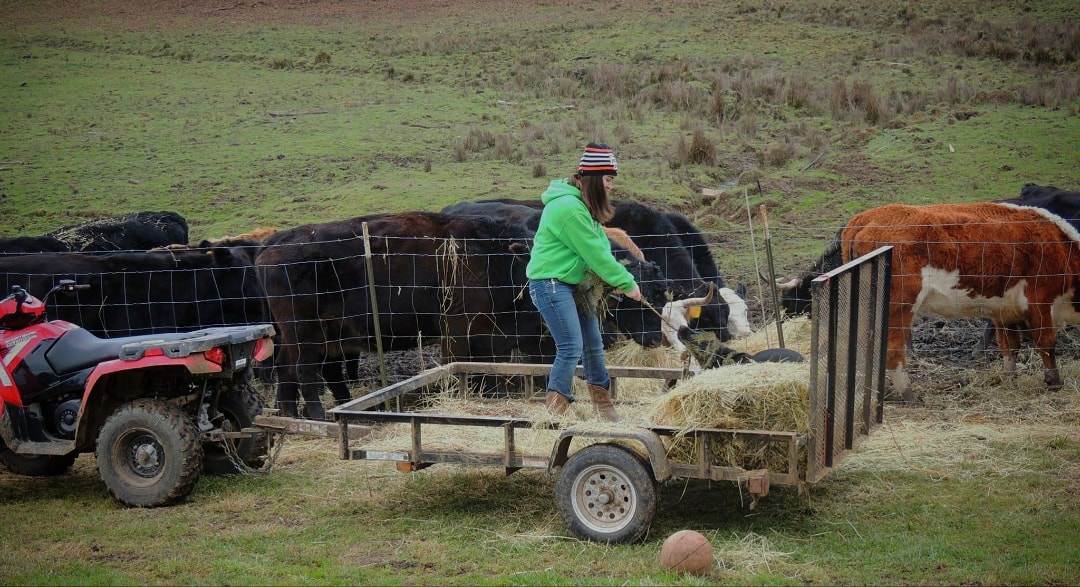On a chilly morning in late November, a young female farmer in western Oregon jumped out of bed at the crack of dawn to feed her herd of cattle. Racing the morning school bus that would soon pull into the driveway of her family’s ranch, she throws five hay bales into a lopsided trailer, battling mud and muck to reach her herd. Armed with a hay knife in her right pocket and her trusty hound dog, Jeb, by her side, she begins to throw breakfast across the fence, struggling to lift the bales, but determined to get the job done. Fifteen minutes later, she takes a break from the heavy lifting to play tug-of-war with a tree branch that Jeb has thrown onto the trailer. I smile and snap a picture: this may be what the future of farming looks like.
This photograph of a young female farmer is as a witness to the United State’s changing agricultural demographics. Highlighting the conflicting themes of “labor,” “play,” and “child-like innocence,” it demonstrates that agriculturalists, no matter the age, must often sacrifice personal comfort for the responsibilities of work. This image, and the young woman in it, challenges the current stereotype of what we picture as an “American farmer.” It contextualizes the future of agriculture within the confines of documentary imagery, daring viewers to envisage -both- the personal life and future of the photograph’s subject.
Female farmers are one of the most rapidly growing segments of the country’s changing agricultural demographics. Between 1982 and 2012, the number of female-operated farms more than doubled, now comprising approximately 30 percent of all farm operators in the U.S. (USDA 2014). Answering the call for photographers and visual social scientists to document and share the images and stories of women farmers and growers, this image is one example of how future perceptions might change. Despite the great increase in the number of female farmers, however, this image may appear foreign to folks accustom to the historical stereotypes of U.S. agriculturalists. More often than not, when asked to picture a “farmer,” minds rush to an image of an older, white male, most likely in the middle of a corn field in the Mid-West. He is likely wearing muddied plaid, Wrangler jeans, and his face is lined by wrinkles that hallmark decades of hard work.
Regardless of the demographic changes and stereotypes of domestic farming, the cultural, historical, and social facets of agricultural institutions remain embedded within the occupation of farming. The patriarchal nature and sexual division of labor observed amongst U.S. farmers muddles our understanding of occupational segregation. Moreover, gendered access to land, equipment, and agricultural knowledge is complicated by the fact that few women receive formal training as farmers. Female agriculturalists are regularly excluded from the informational networks of male farmers (Sachs 1983: 112). As a result, educational and social organizations uniquely designed for female spaces are critical for empowering these farmers to gain access to resources, build social capital, and help elevate marginalized voices in public spaces (Penunia 2011).
This image’s contrast between “labor” and “play” is a contrast to its child-like innocence. If the young woman chooses to pursue a future in farming, she will be faced with a number of barriers that remain ingrained in the profession and its legacy of patriarchal ideals and deep-rooted sexism. For now, she will remain captured in this image: smiling – taking a brief solace from the hard work of farm life – indifferent to what her future in agriculture might look like.
Works Cited
Penunia, Esther. 2011. The Role of Farmers’ Organizations in Empowering Rural Women. Retrieved from http://www.un.org/womenwatch
Sachs, Carolyn. 1983. The Invisible Farmers. Totowa, NJ: Rowman & Allanheld.
USDA. 2014. “2012 Census of Agriculture: Race/Ethnicity/Gender Profile.” Retrieved from https://www.agcensus.usda.gov

Commentary on Rachel Tanur's Works: Alaska Commercial Fishing 03